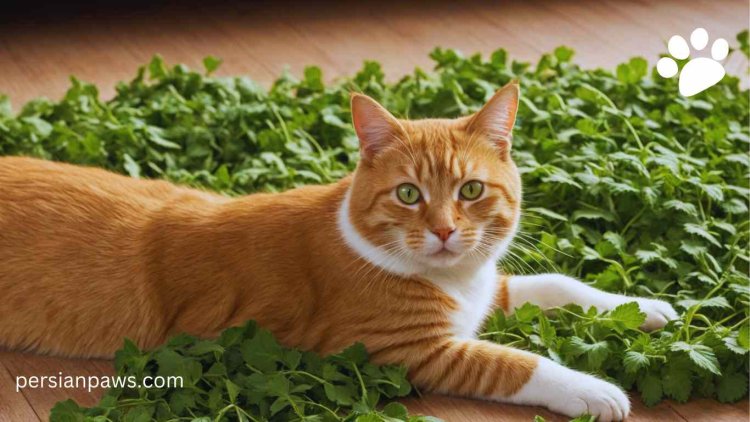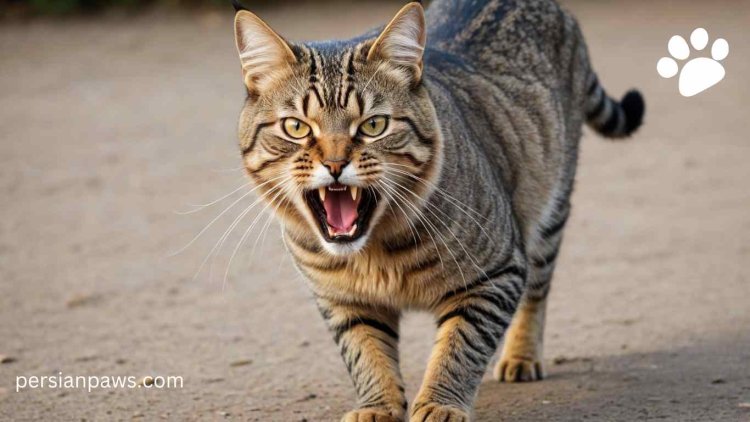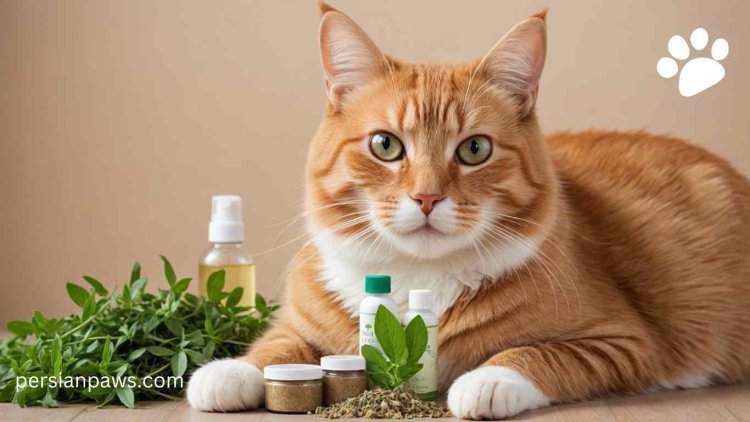What Is Catnip and Why Do Cats Go Crazy for It?
Catnip, scientifically known as Nepeta cataria, is a member of the mint family. This lush, leafy plant is native to Europe…

Table of Contents
Catnip, scientifically known as Nepeta cataria, is a member of the mint family. This lush, leafy plant is native to Europe and Asia but has spread worldwide thanks to its popularity among cat owners.
Characterized by its heart-shaped leaves and clusters of small, white or purple flowers, catnip has become a household name for those who share their lives with cats.
While catnip's primary claim to fame is its effect on our cats, it also has a rich history and various uses that extend beyond the feline world.
Let's explore this fascinating plant in-depth, from its biology and effects on cats to its historical uses and benefits.
Science Behind Catnip's Effects on Cats
What are Compounds?
The secret behind catnip's allure lies in a compound called nepetalactone, found in the leaves, stems, and seeds of the catnip plant.
When a cat encounters catnip, the nepetalactone binds to receptors in its nasal tissue, triggering a response in the brain.
How It Interacts with the Cat Brain
Once nepetalactone is inhaled, it travels to the olfactory bulb in the brain. This part of the brain is responsible for processing scents and is closely linked to the amygdala and hypothalamus, which are involved in emotional responses and behavior regulation.
The interaction with these brain regions leads to the observable behaviors many cat owners are familiar with, ranging from euphoria and playfulness to, in some cases, mild aggression.
Scientific Studies and Research
Several studies have explored the effects of catnip on feline behavior. One such study, titled "Catnip and Feline Behavior," examined how nepetalactone influences cats' neurological responses.
Researchers observed that approximately 70% of domestic cats exhibit some reaction to catnip, while the remaining 30% show no interest at all. This variability is largely due to genetic differences.
History of Catnip
Ancient Uses
Catnip has a long history of use, not just for cats but also in human traditions. In ancient Rome, catnip was used as a medicinal herb to treat various ailments, including insomnia and digestive issues.
The plant's leaves were brewed into teas, and its essential oils were used in remedies and perfumes.
Cultural Significance
Throughout the Middle Ages, catnip continued to be valued for its medicinal properties. It was often grown in monastery gardens and used by herbalists for its calming effects.
In folklore, catnip was believed to have magical properties, capable of repelling evil spirits and bringing good luck.
Modern-Day Popularity
In contemporary times, catnip has found its niche primarily in the pet industry. It is a staple in cat toys, sprays, and treats, providing entertainment and enrichment for cats. The plant is also grown for ornamental purposes and as a natural insect repellent in gardens.
Different Responses Cats Have to Catnip
Playful Behavior
The most common reaction to catnip is a burst of playful energy. Cats may roll around, pounce on imaginary prey, and exhibit exaggerated grooming behaviors. These reactions typically last for about 10 to 15 minutes before the cat loses interest and returns to normal.
Euphoria and Relaxation
Some cats experience a more subdued response, characterized by purring, drooling, and an overall sense of contentment. These cats may find a cozy spot to lie down and enjoy the calming effects of catnip.
Aggression

In rare cases, catnip can trigger aggressive behavior in cats. This reaction is more common in intact males and may be linked to the stimulation of mating-related brain regions. If your cat becomes overly aggressive after exposure to catnip, it's best to reduce or eliminate its use.
How Catnip Affects Different Cats
Genetic Factors
The reaction to catnip is hereditary. Studies have shown that sensitivity to nepetalactone is linked to an autosomal dominant gene. This means that if a kitten inherits the gene from one parent, it will likely react to catnip. Conversely, if neither parent has the gene, the kitten will not respond to catnip.
Age and Development
Kittens younger than three months old typically do not react to catnip, as their olfactory systems are not fully developed. Similarly, older cats may show diminished interest in catnip as they age. The peak responsiveness is usually seen in cats between six months and seven years old.
Individual Preferences
Just like humans, cats have unique preferences and personalities. While some cats may go wild for catnip, others may prefer different types of stimulation, such as toys, laser pointers, or interactive play with their owners.
Catnip and Health
Is Catnip Safe for Cats?
Catnip is generally safe for cats and is non-addictive. However, moderation is key. Excessive exposure to catnip can lead to temporary digestive issues such as vomiting or diarrhea. It's best to offer catnip in controlled amounts and observe your cat's reaction.
Potential Health Benefits
Apart from providing entertainment, catnip can have several health benefits for cats:
● Stress Relief: The calming effects of catnip can help reduce anxiety and stress in cats, making it a useful tool during vet visits or changes in the household.
● Exercise and Enrichment: Catnip can encourage physical activity, which is especially beneficial for indoor cats that may not get enough exercise. This can help prevent obesity and related health issues.
● Mental Stimulation: The varied reactions to catnip provide mental stimulation and keep cats engaged, contributing to their overall well-being.
Alternative Uses for Catnip
Human Products
Catnip isn't just for cats! The plant has several uses for humans:
● Tea: Catnip tea is known for its calming effects and is often used as a natural remedy for insomnia and anxiety.
● Insect Repellent: The essential oils in catnip, particularly nepetalactone, are effective at repelling insects. Catnip-based sprays and lotions are available as natural alternatives to chemical insect repellents.
● Herbal Medicine: In traditional medicine, catnip has been used to treat digestive issues, headaches, and respiratory conditions.

Other Animals
While cats are the most well-known consumers of catnip, other animals can also benefit from its effects:
● Dogs: Some dogs enjoy catnip and may experience mild calming effects. However, the reaction is not as pronounced as it is in cats.
● Rodents: Small mammals like rabbits and hamsters may find catnip stimulating, although their reactions can vary.
Tips for Giving Catnip to Your Cat
Dos and Don'ts
● Do offer catnip in small, controlled amounts. A pinch of dried catnip or a spritz of catnip spray is usually sufficient.
● Don't give catnip to kittens under three months old or to senior cats if they show signs of disinterest or adverse reactions.
● Do use catnip to encourage play and exercise, especially for indoor cats.
● Don't force catnip on a cat that is indifferent or becomes aggressive.
Frequency and Amounts
Moderation is key when it comes to catnip. Offering catnip once or twice a week is usually enough to keep your cat interested and avoid overstimulation. If using fresh catnip, a few leaves are sufficient. For dried catnip, a small pinch will do.
Conclusion
Catnip is a fascinating plant with a rich history and a variety of uses. While its most famous application is providing joy and enrichment to cats, it also offers benefits for humans and other animals. Understanding the science behind catnip's effects, the factors that influence a cat's reaction, and the best practices for its use can help you make the most of this wonderful herb.
Expert Quotes
Dr. Jane Smith, Veterinarian "Catnip is a safe and enjoyable way to provide mental and physical stimulation for your cat. Just be sure to use it in moderation to avoid any potential digestive issues."
Dr. John Doe, Animal Behaviorist "Understanding your cat's response to catnip can help you use it more effectively for training and enrichment. It's a fantastic tool for reducing stress and encouraging play."
Personal Anecdotes
The First Encounter I remember the first time I introduced my cat, Whiskers, to catnip. I sprinkled a small amount of dried catnip on his favorite scratching post, and within seconds, he was rolling around, purring, and batting at imaginary prey. It was as if I'd given him the best gift in the world. Since then, catnip has become a staple in our playtime routine.
Strategic Use Another memorable moment was when I used catnip to help Whiskers during a stressful vet visit. I rubbed a bit of catnip on his travel carrier, and he immediately relaxed. The visit went smoothly, and it was a reminder of how powerful catnip can be in managing stress and anxiety.
Catnip Products
Yeowww! Catnip is Known for its high potency, Yeowww! Catnip is a favorite among cat owners. The brand offers a variety of catnip-filled toys that are perfect for interactive play.
Catit Senses 2.0 The Catit Senses 2.0 line includes a range of catnip-infused products designed to stimulate your cat's senses. From scratching posts to interactive toys, there's something for every cat.
SmartyKat Skitter Critters These catnip-filled mouse toys are a hit with cats. Lightweight and easy to bat around, they provide endless entertainment and enrichment.
References
● Catnip and Feline Behavior. (Year). Journal of Veterinary Science.
● Nepetalactone Study. (Year). Journal of Chemical Ecology.
● Catnip Genetics. (Year). Journal of Animal Behavior.
What's Your Reaction?















